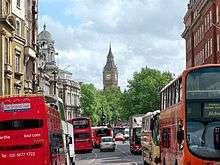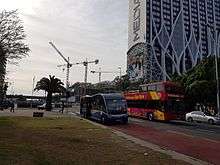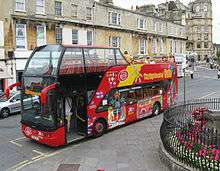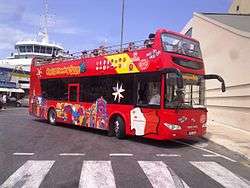City Sightseeing
 | |
|
| |
| Parent | Enrique Ybarra |
|---|---|
| Founded | 1999 |
| Headquarters | Spain |
| Service type | Open top bus tours |
| Website | www.city-sightseeing.com |









.jpg)
City Sightseeing is a sightseeing bus tour operator. It provides tour bus services in more than a hundred cities around the world. The tours are operated by red open top double-decker buses.
The tourist attraction buses travel near major landmarks, while a prerecorded or live commentary is provided through headphones to passengers. Tourists may leave and board the company buses within their ticket's time limit at special bus stops on a circular route. This is called hop-on-hop-off.
Tickets are issued for either one or two day rides, and are purchased at tourist attractions or online. In 2011, nearly 13 million tourists took City Sightseeing tours.[1]
In 2015, Californian officials raised safety concerns about City Sightseeing tours after certain irregularities were discovered and a major crash occurred in San Francisco.
Company history
The City Sightseeing name was first used in 1972 after Peter Newman used it for his City Coach Lines company, which ran tours of London four times a day.
In 1998, Ensignbus revived the name and developed the red livery in the Spanish city of Seville. There it helped an established sightseeing operator relaunch itself with double-deckers, using the experience and expertise developed with London Pride Sightseeing, through Ensignbus' vehicle business. With the sale of the London Pride Sightseeing, Peter Newman stated his intention to introduce a global brand of sightseeing buses. It also set up operations in Sydney, Australia, not as a franchise, but directly owned, during this year.[2]
In 1999, city sightseeing was officially launched at the London World Travel Market.
In March 2000, the franchise model was initiated, with tours starting in Glasgow, Scotland. Startup operations employed a British manager until local staffs were trained. During this year, operations expanded in the UK in York, Edinburgh, and Bath. Edinburgh's Lothian Buses introduced the first purpose built open top low floor buses. In December of that year, the online booking system was introduced.
In 2001, operations expanded further in the UK, Spain, Australia and into Copenhagen, Denmark.
In 2002, operations in Alberta, Canada opened but have since closed. Operations also expanded in the UK. In May of that year, Ensignbus acquired City Sightseeing's biggest rival, Guide Friday, which had a base in Stratford-upon-Avon and operated tours across the UK and in major European cities. Operations were either re-branded as City Sightseeing, or absorbed into existing operators where Guide Friday had been a direct competitor. The acquisition brought City Sightseeing's operations up to nearly 70 cities worldwide with nearly 250 vehicles.
In 2003, operations started in Italy. During this year, City Sightseeing introduced the first purpose-built sightseeing bus. It was an Ayats Bravo City bodied Volvo B7Ls. They featured equipment specifically designed for tours and were "Low floor." These appeared first in Spain and then in the UK. By 2004 they were featured around the world.
Since 2004, the company has been part of Singapore Ducktours.
Ensignbus owned the operations in Bath, Cardiff, Eastbourne and Windsor until its subsidiary, Bath Bus Company, was sold to the RATP Group in February 2011.[3][4][5] It also owned the operation in Cambridge and Stratford-upon-Avon, but these were passed to Stagecoach, who also provided normal bus services in that area.
In 2011, Ensignbus sold its 100% ownership of the business to the Spanish franchisee Enrique Ybarra's City Sightseeing Worldwide of Spain.[6]
Ensignbus retained its ownership of City Sightseeing in Sydney,[7] but sold its interest in City Sightseeing Italy and its shareholding in Washington, D.C.. This was sold to Big Bus Tours in September 2011. Sydney, along with a number of other locations, including Munich, Frankfurt, Perth and Bristol have all left City Sightseeing, and now operate independently. In the case of Sydney, it now operates as the Sydney Explorer. Following this, the other Australian operations have also chosen to operate under the Explorer brand. Melbourne is the exception that still operates as City Sightseeing. The Mornington Peninsula service which commenced 1 November 2014, ceased on 25 January 2015.[8]
According to its website in November 2016, City Sightseeing had operations in 109 cities in 35 countries.[9]
Safety issues
In November 2015, a City Sightseeing bus injured 20 people in a crash at Union Square, San Francisco. This was due to failed brakes, according to the driver.[10] A city official questioned the safety of City Sightseeing tours, and the California Public Utilities Commission released a statement describing various irregularities and problems with City Sightseeing, including multiple permit suspensions since 2007 due to security infractions.[10]
Franchise model
The company has been largely developed along the franchise model. Some operations were completely owned by City Sightseeing, while some were joint ventures; however, the majority of tours are now operated by franchisees, either existing bus operators in the locality or new companies. The new companies either rebrand existing vehicles or introduce new ones.
Operators have the choice of flexibility in how much direct involvement with City Sightseeing company they have. They choose vehicles and systems appropriate to themselves.
Through the franchise model, operators have access to group expertise to solve problems, and to providers of equipment such as off-board ticketing, GPS-linked commentary systems and vehicle refurbisher's. Operators can also take advantage of block negotiation with promotional partners that may not necessarily wish to deal with smaller operators.
At a minimum, the franchise operator must carry the City Sightseeing red base color and graffiti style. They must use the global booking web-site, and a percentage of any revenue taken is returned to City Sightseeing. In recent times, however, new cities have maintained their own liveries (such as Helsinki and Gothenburg), and entire countries such as Italy have decided to opt out of the global ticketing arrangements whilst other locations such as Baku, Kiev and Granada have ceased operating as City Sightseeing.
Operators are free to apply a specific local branding within the red scheme, with local identities, or the Guide Friday name, retained if thought necessary.
Locations served
As at November 2016, City Sightseeing tours operate in the following cities:[9]
 Australia
Australia
Brisbane
.svg.png) Belgium
Belgium
 Canada
Canada
 Colombia
Colombia
 Cyprus
Cyprus
 Czech Republic
Czech Republic
 Denmark
Denmark
 Estonia
Estonia
 Finland
Finland
 France
France
 Georgia (country)
Georgia (country)
 Germany
Germany
 Greece
Greece
 Hungary
Hungary
 Iceland
Iceland
 Ireland
Ireland
 Italy
Italy
 Luxembourg
Luxembourg
 Malta
Malta
 Netherlands
Netherlands
 Norway
Norway
 Panama
Panama
 Peru
Peru
 Poland
Poland
 Portugal
Portugal
 Russia
Russia
 Singapore
Singapore
 South Africa
South Africa
 Spain
Spain
- Barcelona
- Benalmádena
- Cádiz
- Córdoba
- Jerez
- Las Palmas de Gran Canaria
- Lleida
- Málaga
- Palma de Mallorca
- Santa Cruz de Tenerife
- Santander
- Seville
- Toledo
 Sweden
Sweden
 United Arab Emirates
United Arab Emirates
 United Kingdom
United Kingdom
- Bath
- Belfast
- Bournemouth
- Brighton
- Cambridge
- Cardiff
- Chester
- Derry
- Edinburgh
- Glasgow
- Inverness
- Llandudno
- London
- Newcastle upon Tyne / Gateshead
- Norwich
- Oban
- Oxford
- Stratford-upon-Avon
- Windsor
- York
 United States
United States
See also
References
- ↑ "dnata". www.dnata.com. Retrieved 2016-06-02.
- ↑ About City Sightseeing City Sightseeing
- ↑ The History of Ensignbus Ensignbus
- ↑ Tour de France: city bus firm bought by European business Bath Chronicle 2 March 2011
- ↑ RATP Dev announces the acquisition of the Original Tour RATP Group 11 September 2014
- ↑ Ensignbus sells City Sightseeing Focus News
- ↑ City Sightseeing – Banksmeadow Australian Bus Fleet Lists
- ↑ Losses bring tourist bus to an early halt Mornington Peninsula News 26 January 2015
- 1 2 City Sightseeing. "City Sightseeing Tours". City Sightseeing. Retrieved 20 November 2016.
- 1 2 Woodrow, Melanie (2015-11-17). "CPUC: San Francisco tour bus involved in crash never inspected by CHP". ABC7 San Francisco. Retrieved 2015-11-17.
External links
 Media related to City Sightseeing at Wikimedia Commons
Media related to City Sightseeing at Wikimedia Commons- Company website
